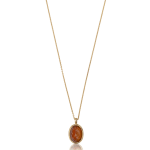



Roman
Tyche carnelian gold pendant, Roman, circa 1st - 2nd century AD
Carnelian
Length of intaglio: 1.4 cm
Length of chain: 18 in (adjustable to 16 in)
Length of chain: 18 in (adjustable to 16 in)
Further images
The oval carnelian gem engraved with a profile head of the goddess Tyche, wearing her traditional mural crown of the city walls and towers, her hair falling in tresses at...
The oval carnelian gem engraved with a profile head of the goddess Tyche, wearing her traditional mural crown of the city walls and towers, her hair falling in tresses at her neck. Set in a modern 18 carat gold pendant.
Provenance
Gustave Mustaki Collection, Alexandria, acquired in the early part of the 20th century and exported to England before 1953Gustave Mustaki moved from Greece to Alexandria, Egypt, when he was a boy. A fanatic collector from a young age, over his lifetime he amassed a huge collection. Towards the end of the 1940s he applied to the Egyptian government to export his collection. Although the government kept some items of importance, they granted permission for several crates of statuettes and amulets to be shipped to London. The full contents were recorded by by the shippers, on 15th May 1953. Though the process had begun several years earlier, by late 1953 Harrods had received delivery of the cases and the objects were sent to Mustaki's daughter Elsa MacLellan and have been slowly dispersed since
Literature
Tyche (ΤΥΧΗ, τύχη in Greek), the Greek goddess of fortune, originated in the 4th century BC, flourished in the Hellenistic period, and was adopted by the Romans as Fortuna. She controlled the fortunes of individuals, armies, cities, and kingdoms. She also served as the patron goddess and protector of cities, as Athena did for Athens. She served as the city’s symbol, and images of the goddess—generally a statue erected in a temple or civic space—showed her wearing the city walls as a crown. Images of Tyche wearing the mural crown are common symbols on coins of the late Hellenistic and Roman periods, especially in the eastern Mediterranean.Images of the goddess were worn as jewellery to protect the wearer. Tyche brought both good and bad fortune, and wearing a ring with an image of the goddess was also thought to ward off her malevolent tendencies. Tyche/Fortuna was also an important member of the household gods. For a similar image on a gem see Yale University Art Gallery, acc. no. 1986.99.1.



